 |
 |
 |
| |
Incidence Anal Squamous Intraepithelial Lesions (SIL) and Predictors of in the SUN Study after One Year of Follow-up
|
| |
| |
Reported by Jules Levin
15th CROI, Feb 3-6, 2008, Boston
L. Conley1, T. Bush1, T. Darragh2, J. Palefsky2, E. Kojic3, S. Cu-Uvin3, E. Unger1, H. Martin4, E.T. Overton5 and J.T. Brooks5
1Centers for Disease Control and Prevention, Division of HIV/AIDS Prevention, Atlanta, GA, 2University of California, San Francisco, CA, 3Miriam Hospital, Providence RI, 4Park-Nicollet Institute, Minneapolis, MN, 5Washington University School of Medicine, St. Louis, MO
The findings and conclusions in this presentation have not been formally disseminated by the Centers for Disease Control and Prevention and should not be construed to represent any agency determination or policy
We evaluated data from the Study to Understand the Natural History of HIV/AIDS in the Era of Effective Therapy ('SUN' Study), a prospective cohort study designed to examine risk factors for complications of treated HIV infection and longer survival.
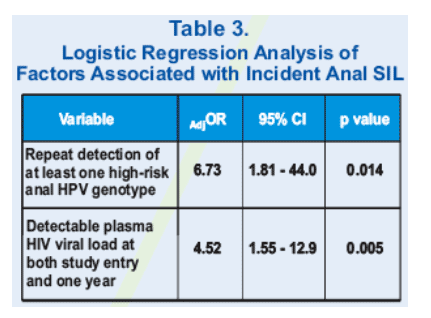
AUTHOR CONCLUSIONS
In this large cohort of generally healthy, HIV-infected men and women, the one-year incidence of anal SIL was 12%
Notably, CD4 cell count and high risk sexual behaviors in the previous year, including unprotected anal sex and multiple partners, were not
associated with incident anal SIL
AUTHOR RECOMMENDATIONS
Consider anal cytology in HIV-infected patients, particularly if they are repeatedly found to have either:
--detectable plasma HIV viral loads
--the same high-risk anal HPV genotype
Extend research to determine the most appropriate follow-up of abnormal cytological findings detected by blind anal swab
Abstract
Background: The incidence of anal cancer and its precursor SIL are increasing in men who have sex with men (MSM). Incidence of SIL and risk factors for its development in HIV-infected individuals, including heterosexual men and women, have not been extensively investigated.
Methods: The SUN Study is an on-going prospective cohort study of HIV-infected outpatients seen at clinics in Denver, Minneapolis, Providence, and St. Louis. At baseline, and annually thereafter, all patients complete a behavioral risk questionnaire and providers collect, among other specimens, separate Dacron anorectal swabs for cytologic examination as well as HPV detection and genotyping using the Roche Linear Assay.
Results: Complete data at both the baseline and 1-year follow-up visits were available for 371 participants. At baseline, 100 patients were diagnosed with anal low-SIL and 28 with high-SIL; these patients were excluded from this analysis.
Of the remaining 243 patients with negative anal cytology or atypical squamous cells (ASC), 76% were male and 86% had HPV detected.
At 1 year, the median age was 42 years, 94% were receiving HAART, 57% had CD4 cells counts (CD4) >500 cells/mm (median: 529.5 cells/mm ) and 79% had undetectable viral loads.
Anal cytologic results at 1 year were: negative for 190 (78%), ASC for 23 (9%), low-SIL for 25 (10%) and high-SIL for 5 (2%).
Univariate analysis indicated that the following factors were associated with incident SIL (p<0.05): at least one high risk HPV type detected at each visit, a detectable HIV viral load at each visit, current cigarette smoking, non-adherence (defined as missing >=1 ARV dose in a 3-day period) and use of >1 illicit drug
(other than marijuana) in the last 30 days.
In multivariate analysis, detection of a high-risk HPV type at each visit (OR 10.4, 95%CI 1.3-81, p=0.026), detectable viral load at each visit (OR 3.8, 95%CI 1.3-11, p=0.015) and illicit drug use (OR 6.4, 95%CI 1.0-40, p=0.047) remained
associated.
Conclusions:
In this large cohort of generally healthy, HIV-infected men and women, the incidence of anal SIL at one year was 12%.
Notably, CD4 level and high-risk sexual behaviors (e.g. unprotected anal sex, multiple partners) in the previous year were not associated with incident SIL. Clinicians may wish to consider anal cytology and HPV screening in HIV-infected patients, particularly if they are found repeatedly to have detectable HIV viral loads.
BACKGROUND
The incidence of anal cancer and its precursor anal squamous intraepithelial lesions (SIL) are increasing in HIV-infected men who have sex with men (MSM)
Incidence of anal SIL and risk factors for its development in HIV-infected persons, including heterosexual men and women, have not been extensively investigated
OBJECTIVES
Describe the incidence of, and factors associated with, incident anal SIL among a cohort of HIV-infected MSM, non-MSM and women
METHODS
We evaluated data from the Study to Understand the Natural History of HIV/AIDS in the Era of Effective Therapy ('SUN' Study), a prospective cohort study designed to examine risk factors for complications of treated HIV infection and longer survival
Baseline and 1-year anal cytology data were available for 371 of the 682 enrolled study participants
Of these 371 persons, 128 were diagnosed with anal SIL at baseline, leaving 243 participants for whom we could assess incident anal SIL
Multi-year prospective observational cohort study 682 adults at 7 clinics in 4 U.S. cities
Followed during routine care with additional study-specific testing at baseline and every six months
Inclusion criteria:
--Either ARV-naive with CD4 cell count 100-500 cells/mm or HAART-experienced with CD4 cell count >100 cells/mm
--No immunomodulating therapy or AIDS-defining illness in 60 days preceding
baseline enrollment
Baseline and 1-year examinations included:
--Assessment of behavioral risks and self-reported sexuality by audio computerassisted self-interview
--Clinician collection of Dacron anal swabs for:
Cytopathological examination
HPV detection and genotyping (Roche Linear Assay)
RESULTS
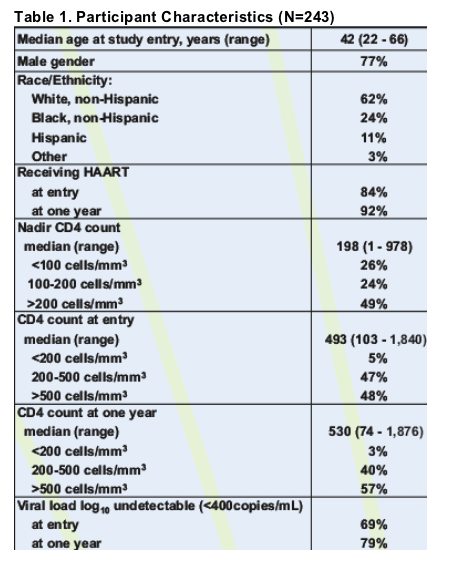
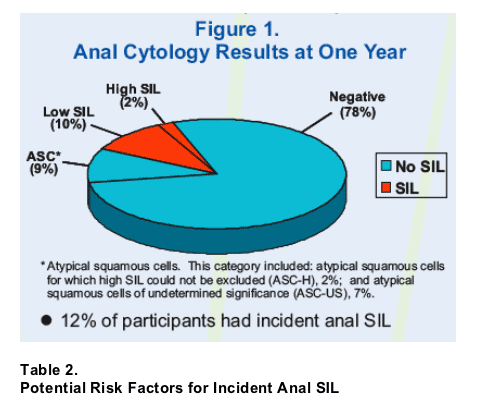
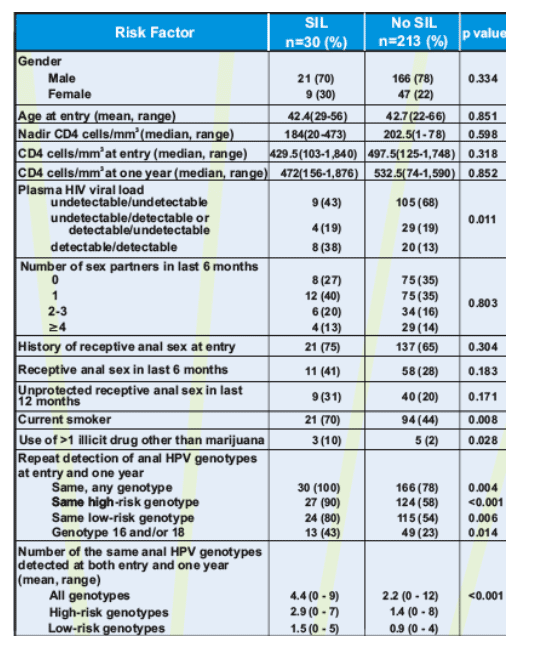
In univariate analysis, factors associated with incident anal SIL included:
--Current smoking
--Use of more than one illicit drug other than marijuana
--Repeatedly detectable plasma HIV viral load
--Detection of the same anal HPV genotype at both visits
--Detection of a greater number of the same anal HPV genotypes at both visits
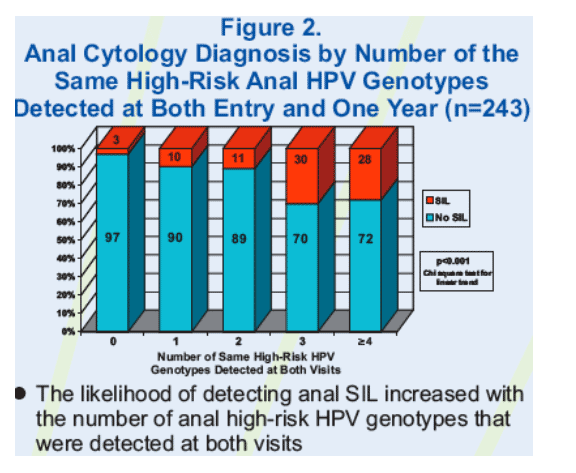
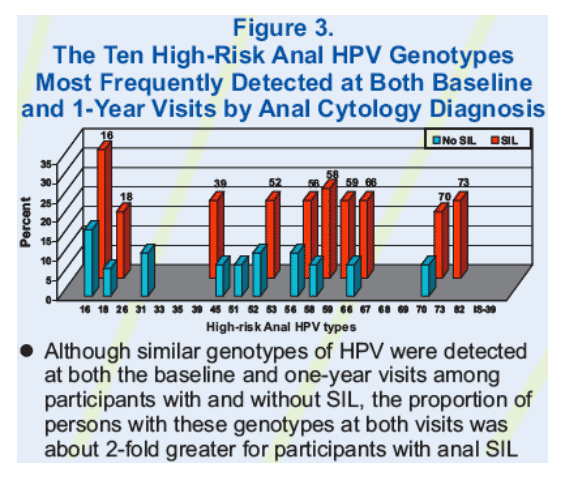
|
| |
|
 |
 |
|
|